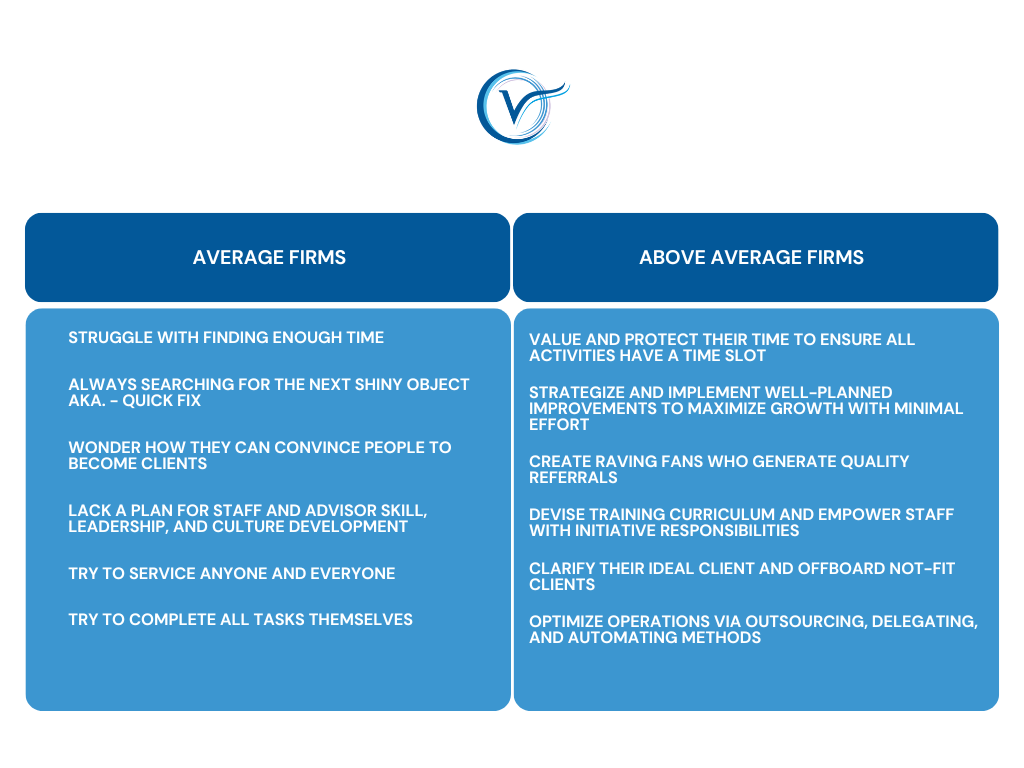You might wonder how some businesses skyrocket forward, seemingly effortlessly, while others struggle to get off the ground. It’s tempting to chalk it up to luck or insider secrets. But the truth is much more straightforward: high-performing firms invest wisely in time, in people, and in systems. They don’t just hope to grow. They plan for it.
In this guide, we’ll explore the practical steps that separate Above Average businesses from the rest, and why those who commit are the ones who win.

Master Your Time & Energy
Time is the one resource no one can buy more of. Once it’s gone, it’s gone forever.
Time blocking [1] is a simple yet powerful tactic: dedicate specific hours for key tasks, strategy, team huddles, client meetings, and stick to them.
Here’s why it works:
- You feel more energized and focused.
- Clients appreciate your consistency and availability.
- Your calendar becomes predictable, which allows for better planning.
Instead of scrambling to squeeze work in, you’re proactive. You guard your time as you would a precious resource, because it is.
Say No to “Shiny Object Syndrome”
Above Average firms avoid SOS by having streamlined business processes and transparent systems to prioritize and organize new ideas, solutions to issues, and dreams.
They don’t band-aid an issue but rather proactively seek permanent solutions. They avoid the madness that drains energy and resources and often leads to workplace burnout.
It’s easy to chase every new idea or trend, but scattershot strategies rarely deliver. That’s where streamlined systems come in.
Keep a central, transparent log of ideas, challenges, and dreams. Note what each one could bring to the table, then assign someone to dig deeper.
Review everything monthly with your leadership team and roll out the winners thoughtfully. Share the plan with your whole company.
Why this matters:
- You stay agile, adapting as needed.
- You cut wasteful expenditures.
- Staff feel heard, not overwhelmed.
- You build trust and reduce surprises.
Trust [2]isn’t fluff as it drives performance. One Slack-commissioned study showed that trusted employees are 2× more productive and 4.3× more satisfied.
Create Raving Fans [3]Through Marketing and Service
Growth isn’t just about winning new clients; it’s about turning current clients into your biggest advocates.
Start by clarifying who your ideal client is. What do they need? What keeps them up at night? Tailor your messaging and offerings accordingly.
Track marketing metrics to see what’s working and what isn’t. Whether on your website or social media, refresh your brand messaging regularly.
But don’t stop there. Train your team to deliver experiences that exceed expectations.
When you delight, clients refer. They spread the word without prompting. That kind of endorsement? Priceless.
Develop a Master Staffing Plan
Your people are your most valuable asset. Investing in them doesn’t just feel good—it pays real dividends.
Sit down individually with each team member. Talk about their passions, skill sets, and career aspirations. Then craft a roadmap together, including training and mentoring.
Review this roadmap every quarter. Adjust goals, offer support, and course-correct when needed.
This approach:
- Cultivates accountability.
- Clarifies roles and expectations.
- Helps you identify skill gaps early.
The result? A more engaged, loyal, and high-performing team.
Focus on the Right Clients
Trying to please everyone only dilutes your impact and your sanity.
Instead, define your ideal client profiles. Pin down the minimum fee, service tiers, staffing needs, and deliverables for each.
Now, segment your client base [4]. Some clients may be better served, or happier, with another firm.
This clarity:
- Frees up capacity.
- Sharpen your brand identity.
- Improves staff morale.
- Reinforces your reputation.
It’s freeing to know who you serve, and who you don’t.
Delegate with Clarity and Accountability
No one can, or should, do it all. When founders try, they burn out.
Instead, embrace delegation. Break tasks into meaningful chunks. Assign them clearly. Track progress and be accountable.
Use frameworks like IDEOS™ [5] to help you think through what to delegate, to whom, and when.
The benefits are dramatic:
- You increase capacity.
- You lift profitability.
- You attract and retain top talent.
When responsibilities are clear, everyone wins.
Transform and Thrive
Ask yourself: Are we average, or Above Average?
Changing that answer means embracing a growth mindset across four domains:
- Processes
- People
- Productivity
- Profitability
Start small. Pick an area that needs attention, maybe your time management or marketing approach. With every tweak you make, energy builds. Momentum grows.
Before long, you’ve transformed from average to exceptional.
Why It Matters
Every effort you make toward building a high-performing business compounds over time. A minute saved, or a better hire, ripples into hours freed, clients delighted, and revenue strengthened.
You’ll attract the staff you want, foster long-term client relationships, and build a business that isn’t just profitable, but sustainable.
E‑A‑T matters here: you’re taking steps grounded in real expertise. You’re acting with authority. And your consistent, transparent efforts build trust, not just with search engines, but with human beings.
Your Next Steps
- Pick one area to improve this quarter, perhaps time blocking or client segmentation.
- Set clear goals and metrics.
- Gather your team and begin small, steady, intentional steps.
- Track progress monthly.
- Celebrate wins. Learn from challenges.
Stay committed. Over time, these actions distinguish the average from the extraordinary.
Building a high-performing business isn’t a one-time effort; it’s a journey. And it’s a journey worth taking.
Maintaining focus and consistency isn’t easy, but the payoff is lasting growth, stronger teams, and a brand that thrives because it earns trust.
Start today, and watch your business rise above the rest.
Frequently Asked Questions (FAQs)
What exactly defines a high‑performing business?
A high‑performing business isn’t just about revenue or flashy growth numbers.
It’s an organization that uses its time and resources wisely, invests in people, embraces clear systems, and consistently delivers exceptional value to clients.
Think of it as a balance of productivity, profitability, and purpose, backed by intentional strategy and trust.
Can small businesses use these strategies, or are they only for large firms?
Absolutely! In fact, small businesses often see faster results because decision-making is more agile. Even basic time-blocking, client segmentation, and structured delegation can make a noticeable impact, without large overheads or complex systems.
What’s the biggest mistake companies make when trying to become high-performing?
Trying to do everything at once. Success isn’t built overnight. It’s better to choose one or two areas like time management or delegation, and commit to improving them consistently, rather than overhauling your entire business at once.
Sincerely,
PS. Want to talk more about how I help businesses make progress and operate better? Click HERE [7]. Want to receive my monthly solutions email? Click HERE [8].
